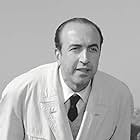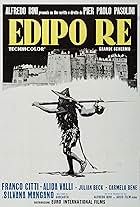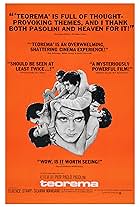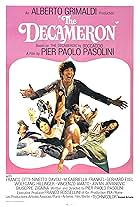IMDb RATING
7.2/10
5.8K
YOUR RATING
Totò and his son Ninetto are drifting on a road in Italy when they meet a speaking crow.Totò and his son Ninetto are drifting on a road in Italy when they meet a speaking crow.Totò and his son Ninetto are drifting on a road in Italy when they meet a speaking crow.
- Awards
- 4 wins & 4 nominations
Totò
- Totò Innocenti
- (as Toto')
- …
Ninetto Davoli
- Ninetto Innocenti
- (as Davoli Ninetto)
- …
Nello Appodia
- Party Guest
- (uncredited)
Gabriele Baldini
- Dante's Dentist
- (uncredited)
Pietro Davoli
- Mascalzone
- (uncredited)
Rossana Di Rocco
- Ninetto's Girlfriend
- (uncredited)
Storyline
Did you know
- TriviaFilm's opening credits are not only displayed on screen but also comically sung in Italian to a jaunty Ennio Morricone score, with a memorably droll rhyming of the film title with the director's full name.
- Crazy creditsThe opening credits are performed as a song.
- ConnectionsEdited into Histoire(s) du cinéma: Une histoire seule (1989)
- SoundtracksUccellacci E Uccellini (Titoli Di Testa)
Composed by Ennio Morricone and Pier Paolo Pasolini
Performed by Domenico Modugno
Featured review
Pier Paolo Pasolini's 'The Hawks and the Sparrows' (the Italian title is 'Uccellacci e uccellini') is a film that is difficult to decipher. In 1966 the Italian director had not yet produced his most controversial works, but this film already shows him as a radical creator, both in terms of the load of ideas he tries to convey in less than the 90 minutes that the film lasts and by the metaphorical way in which he chooses to do it. We are dealing with a parabola allegory including many interesting and innovative cinematic elements, some of them quite funny, but it is not an entertainment film. The problem with this film as with others of Pasolini is that much of the ideological wars that the Italian director and intellectual waged in his time have since been either won or forgotten by history. The result is that looking at this film today, viewers judge it by its cinematic and entertaining qualities, ie exactly those components that for Pasolini were just tools to transmit ideas from the creator of films to his viewers.
The story takes place on an endless road. The road of life? The path that Charlie Chaplin takes at the end of his films? The two characters could actually be the Vagabond and the kid who accompanies Charlot, as seen many years later. Here they are father and son, and on their way they meet landscapes and people who belong to the immediate reality or to pure fantasy. Neo-realism mixes in the world of Pasolini's film with fantasy. People live their lives on the margins of society, women have nothing to put in the pot to feed their families, tenants are threatened with eviction from their homes because they have not paid their rents, prostitutes work in the cornfield. The two heroes, father and son, eternal vagabonds, meet a talking raven who declaims the ideology of the left and travel back in time seven centuries to convert to Catholicism the birds (the hawks and the sparrows in the title) at the urging of St. Francis. Their universe is cruel, an era is coming to an end (symbolised by the funeral of a communist leader), and hawks eat sparrows despite all the efforts of Catholicism. The world is incoherent and ideologies are dying.
The message of the film also translates into an unconventional demonstrative cinematic treatment, rejecting canons, narrative rules, or aesthetics. The film begins with a generic sung to the music of Ennio Morricone. The following scenes seem to be under the influence of neo-realism, even when a group of young people improvise a dance number that would also find its place in the films of Jacques Demy, Pasolini's French contemporary. What follows, however, belongs rather to surrealism combined with the absurd. The acting performances are extraordinary. The only professional actor is Totò, a famous comedian and clown, in one of the great roles of his career. The young Ninetto Davoli, a discovery of Pasolini, at his second film, was quite anonymous and uncorrupted by acting schools to fit perfectly into the style of the film. The rest of the cast is made up of non-professionals and they are the ones who give authenticity to this mixture of social and religious criticism imbued with a dreamlike nihilism that only Pasolini was capable of. 'The Hawks and the Sparrows' is an atypical film even for Pasolini's creation, unequal, but which offers many moments of cinematic pleasure.
The story takes place on an endless road. The road of life? The path that Charlie Chaplin takes at the end of his films? The two characters could actually be the Vagabond and the kid who accompanies Charlot, as seen many years later. Here they are father and son, and on their way they meet landscapes and people who belong to the immediate reality or to pure fantasy. Neo-realism mixes in the world of Pasolini's film with fantasy. People live their lives on the margins of society, women have nothing to put in the pot to feed their families, tenants are threatened with eviction from their homes because they have not paid their rents, prostitutes work in the cornfield. The two heroes, father and son, eternal vagabonds, meet a talking raven who declaims the ideology of the left and travel back in time seven centuries to convert to Catholicism the birds (the hawks and the sparrows in the title) at the urging of St. Francis. Their universe is cruel, an era is coming to an end (symbolised by the funeral of a communist leader), and hawks eat sparrows despite all the efforts of Catholicism. The world is incoherent and ideologies are dying.
The message of the film also translates into an unconventional demonstrative cinematic treatment, rejecting canons, narrative rules, or aesthetics. The film begins with a generic sung to the music of Ennio Morricone. The following scenes seem to be under the influence of neo-realism, even when a group of young people improvise a dance number that would also find its place in the films of Jacques Demy, Pasolini's French contemporary. What follows, however, belongs rather to surrealism combined with the absurd. The acting performances are extraordinary. The only professional actor is Totò, a famous comedian and clown, in one of the great roles of his career. The young Ninetto Davoli, a discovery of Pasolini, at his second film, was quite anonymous and uncorrupted by acting schools to fit perfectly into the style of the film. The rest of the cast is made up of non-professionals and they are the ones who give authenticity to this mixture of social and religious criticism imbued with a dreamlike nihilism that only Pasolini was capable of. 'The Hawks and the Sparrows' is an atypical film even for Pasolini's creation, unequal, but which offers many moments of cinematic pleasure.
- How long is The Hawks and the Sparrows?Powered by Alexa
Details
- Release date
- Country of origin
- Language
- Also known as
- Jastrebovi i vrabci
- Filming locations
- Production company
- See more company credits at IMDbPro
Box office
- Gross worldwide
- $3,348
- Runtime1 hour 31 minutes
- Color
- Sound mix
- Aspect ratio
- 1.85 : 1
Contribute to this page
Suggest an edit or add missing content

Top Gap
By what name was The Hawks and the Sparrows (1966) officially released in India in English?
Answer






























